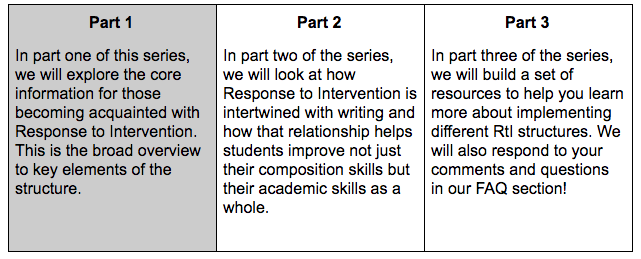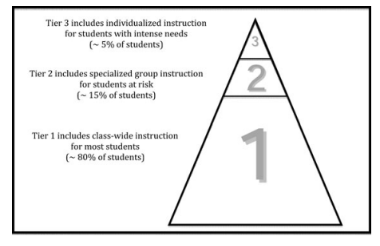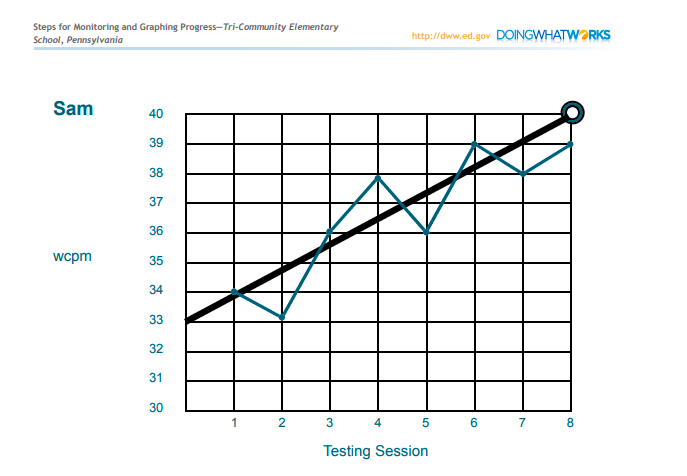We’ve all been there. Another “ding” from your phone means another email. Another email means another call to action from the state or district, listing action steps, deadlines, and seemingly unreachable targets. All the while, it’s hard not to think about the other 55 initiatives that you still haven’t been able to roll out.
How is this different from what we are already doing? Why do we need this? Education can feel like an ever-building stack of new programs.
Some of these programs are not worth the time, effort, and resources required to implement them, while others yield valuable academic and social outcomes. Response to Intervention (RtI) falls into the latter category. Response to Intervention is a programmatic structure of care for student behavior and academics.
Backed by evidence-based science in multiple fields, Response to Intervention seeks the best outcome for all students by identifying and providing targeted support to those most at-risk. Rtl is a lasting framework that aims to reach all students by applying the public health prevention model of vaccinations and treatments.
Much like a doctor asks questions to identify a patient’s risk factors before suggesting a specific test or treatment, educators must screen and test students for factors that research links to being behind grade level. These results establish the portion of the school population that needs intervention before students get behind. In this way, RtI is preventative rather than responsive. After all, getting a flu shot is much more efficient than trying to treat the flu once you are already in the hospital.
About This Series

At the end of the series, you will be able to answer the following big questions:
- What are the basics of Response to Intervention (RtI)?
- How do Response to Intervention and writing live together in my school?
- What do I need to implement a high-quality Writing RtI?
What is Response to Intervention?
First, let’s look at the bigger picture. In “A Problem-Solving Approach to Student Success,” the Wisconsin RtI Center defines RtI as:
- “…a process for achieving higher levels of academic and behavioral success for all students.”
- “…a combination of high quality instructional practice, balanced assessment, and collaboration, all of which are infused with culturally responsive practices.”
- “…a multi-level system of support to identify and respond to student need.”
RtI is not just for a few struggling students; it is a whole-school approach to solving problems. RtI establishes a school culture of believing that all problems, once identified, can be addressed. Much like preventative medicine, RtI seeks to identify and intervene as early as possible before the at-risk factor causes long-term hindrances to growth. It all begins with understanding our population better.
Intervention in the Population
It is important to quickly screen the entire population to group them according to at-risk factors. This provides the fastest and most effective route to restoring and accelerating each child’s education.
What is the path to get there? How do we ensure that No Child is Left Behind and Every Student Succeeds? Mellard, McKnight, & Jordan (2010) illustrate the purpose of RtI in getting 100% of students to reach grade-level or above mastery. Let’s take a deeper look of what is implied through the illustration.

If a teacher’s classroom instruction implements research-based practices and is highly-effective, around 80% of the students will respond by demonstrating on-level or above-level mastery. Note: when a school has lower than 80% of students responding to class-wide instruction, this indicates a need to focus school change on elements of all classrooms.
With 80% of students responding to instruction in the school, we must intervene for the remaining 20%. Systematic and timely interventions are essential for accelerating their learning to on-level mastery. Writing instruction interventions should be appropriately rigorous and research-based for this grouping. If our interventions are effective, then assessments will show that 15% of those 20% will demonstrate they responded to the intervention.
Mellard, McKnight, & Jordan (2010), in one of the most widely read and utilized peer-reviewed articles on RtI, clearly define the remaining 5%: “The third tier, tertiary-level prevention, is often intended for those few students who demonstrate inadequate responsiveness to second tier interventions.” Students in this tier are 3-4 grade levels behind.
Our goal of 100% of students at or above grade level requires that these students receive additional interventions to close that gap as fast as possible. This intervention becomes more prescribed and routinized, relying on the programs that have been researched and proven at a robust level. These students need guaranteed results, and they need them now.
The next tier is often unique to states as it directly relates to special education identification and services. Some states identify Tier III as the implementation of special education while others designate Tier V as providing individualized special education services. Be sure to use online and print resources to closely examine your state’s link between RtI and special education.

Response to Intervention & Special Education
Jose L. Martín, a lawyer focusing on disability litigation and public schools, states that RtI is allowing U.S. public education “to evolve from a reactive model in which students had to seriously deteriorate before being moved on to special education programs, to one that emphasizes early and high-quality research-based interventions in regular programs that generate useful data with which to make key decisions for each struggling student.”
However, RtI has left many educators confused about its connection to and impact on special education. Research and consultation given to states suggests that “(i)n some tier structures the third or fourth tier equates to special education, while in others special education remains outside the RTI tier framework” (Mellard, McKnight, & Jordan, 2010).
In my experience, separating RtI from special education promotes the preventative approach in school culture and academic interventions. The instituted layers promote enough implementation of research-backed curriculum and strategies to catch any and all students before entering special education services. Additionally, each of these levels allow for the collection of data as evidence of exceptionality so that the IEP is directly providing services for what the student needs.
The Individuals with Disabilities Education Act (IDEA) is vital in guiding schools to structures and systems for serving students with exceptionalities. This federal regulation directs schools, parents, and support providers in identifying and supporting students with disabilities. Sec. 300.111 “Child Find” of IDEA is linked with RtI programs:
(a) General.
(1) The State must have in effect policies and procedures to ensure that
(i) All children with disabilities residing in the State, including children with disabilities who are homeless children or are wards of the State, and children with disabilities attending private schools, regardless of the severity of their disability, and who are in need of special education and related services, are identified, located, and evaluated; and
(ii) A practical method is developed and implemented to determine which children are currently receiving needed special education and related services.
According to IDEA, schools can’t wait for parents to bring the concerns to them; instead, schools must have clear, systematic approaches to screening for students with disabilities. By not having a program like RtI, a school could be out of compliance with federal laws and mandates.
RtI thus fulfills the mandate for schools to identify children with disabilities. If all students are screened and monitored using evidence-based assessments, the school institution is properly providing preventative schoolcare to the community.
Assessments: Screening & Monitoring
Data-driven instruction is the heart of RtI systems in schools. Most importantly, RtI requires externally created evidence-based assessments. Our teachers do amazing work; providing teachers with standardized and normed assessments focuses their work in analyzing the data and determining next steps. It prioritizes student need over attempting to design research-based and scientific assessments.
COMPARING THE BEST PRACTICES

Best Practices Cycle for Teaching

Best Practices Cycle for RtI
These graphics show that RtI assessment protocols mirror best practices in our classroom.
Educators give diagnostic assessments to determine needs and then identify scaffolding and differentiation to bring all of their classroom to mastery. Formative assessments come next to determine if students have mastered the content and are growing. They give valuable data to teachers in order to identify changes in instructional approaches and spiraling to continue mastery. When students are approaching the end of a unit of study, summative assessments provide a larger picture of mastery, growth, and readiness for curriculum movement.
RtI mimics the same process with the requirement that it is an evidence-based assessment that helps determine grade, standard, or skill level. The terms may be different but the purpose is the same.
The school year begins with a Universal Screener, which provides an accurate, normed picture on where the student is in mastering grade level material. If the student is above or below grade level, the Universal Screener should identify what level the student is on in the progression.
Using this data, students who are generally 1-2 grade levels behind are then placed into Tier 2 intervention with a highly-qualified teacher. Students 3 or more grade levels behind are placed into Tier 3 intervention with a highly-qualified teacher and a more individualized intervention program.
Throughout the coming weeks, the RtI teachers assess each student’s response to the intervention through Progress Monitoring assessments. These have required intervals from either the purchased program or your state.
Lisa Morris (2013), author of RTI Meets Writer’s Workshop, provides suggested intervals if you have no other references in your district or state:
- Tier 1 (all students): 2-3 times a year/quarterly
- Tier 2 (some students): 1-2 times a month
- Tier 3 (few students): 1-2 times a week
Movement into and out of a Tier can happen in three different ways:
- When the Universal Screener is given again in the winter and the spring to progress monitor all students (Tier I), the data is used to determine who needs to enter and exit based on grade-level readiness.
- Tier 2 and 3 students can move out of or between tiers based on the Progress Monitoring tool used in that Tier. Essentially, if the data proves the gap is closed or closing, the intervention services should be changed.
- When a classroom teacher collects evidence of coursework that is significantly below grade level, the student is given a normed assessment to triangulate with Universal Screener and coursework. Final decision to enter RtI must focus on data triangulation. For more information on Data Triangulation, check out Advancing Assessment Education.
Data Chats and Decision Making
“When determining the degree of success that a student is experiencing, RTI strongly emphasizes the need to go beyond gut instincts and instinctive decision making.”
— Jodi O’Meara
Data is the main driving force of Response-to-Intervention Programs. RtI goes beyond instincts and intuitions; it focuses on providing evidence for what we think and believe about a student’s current progress.
The data we get from assessments must be reliable and accurate. Therefore, the emphasis is on objective, external, and scientific assessments over teacher-created assessments, which may be more subjective. This is not only a best practice for teaching but is also mandated in RtI and Special Education.
A part of the mandated format is to have regularly scheduled and attended data chats. Growth progressions and trend-charts must be distributed, viewed, and discussed as part of the RtI process. These data, especially the progress toward the identified goal, become the deciding factor in continuing, intensifying, or decreasing the provided interventions.
The progress monitoring line charts do not have to be overly complex. They require simple elements to meet state and federal guidelines. See the example below from a Pennsylvania school using RtI data:

Required Graphing Features:
- Student Name
- Y-axis is labeled (Abbreviate: wcpm for words correct per minute) and has appropriate intervals for data points between starting assessment and determined goal
- X-axis is labeled with the frequency of the testing sessions taking place (1, 2, 3 week intervals)
- A target goal is clearly depicted in the upper right quadrant of the graph
- A goal line depicts the necessary growth for each testing session to reach the goal in the required timeframe
- Individual dots are used to mark the individual testing sessions
- A trend line connects the individual testing sessions
For great resources on tracking now without the assistance of assessments or programs, you can visit RTI Building Capacity from The University of Texas to get free access to Excel files that create and track these for multiple students.
What’s Next
In the second part of this series, we will dig into how Response to Intervention impacts the culture of writing in the school. We will also deepen our understanding of how Writing RtI helps focus implementation of a high-performing Writing RtI.

Brenton DeFlitch, M.Ed & EdS served as a Regional Content Coach for Secondary Education Literacy Interventions in Middle Tennessee. Throughout his 13 year career, he has designed school systems and structures for Reading and Writing RtI in both Tennessee and Pennsylvania. As a previous school leader, he oversaw RtI implementation in middle and high schools, conducted fidelity checks, and trained fellow leaders in running intervention systems.


 Help
Help